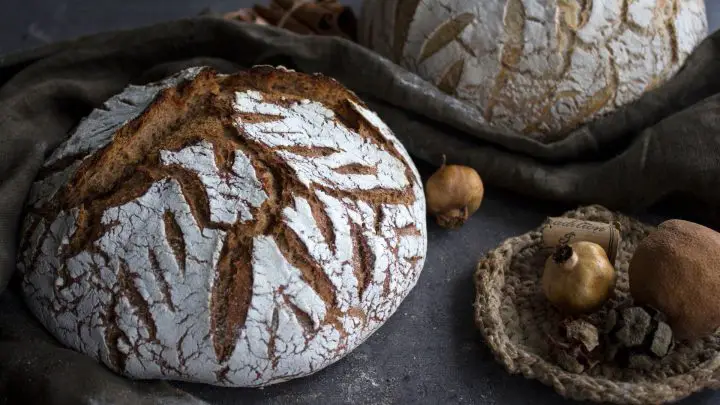Welcome to the world of long-fermented sourdough bread, where patience and time are key ingredients in creating a loaf of exceptional flavor and texture. In this recipe, we will embark on a journey that spans multiple days, allowing the magic of fermentation to transform simple ingredients into a masterpiece of artisanal bread. The slow fermentation process will not only enhance the taste and aroma but also unlock the nutritional benefits and digestibility of the bread.

Table of Contents
- What Is The Importance of a Long Fermentation in Sourdough Bread?
- How Long Should You Ferment Sourdough Bread?
- Why is Temperature So Important in Long Fermented Sourdough Bread?
- What Happens if You Ferment Dough Too Long?
- Long-Fermented Sourdough Bread Recipe
- Benefits of Long-Fermented Sourdough
- Long-Fermented Sourdough
- FAQs

Long Fermentation Sourdough Bread Recipe
This long-fermented sourdough bread recipe is a true artisanal delight. This traditional bread is made using a slow fermentation process that allows the dough to develop complex flavors and textures.
- Total Time: 10 hrs 30 mins
- Yield: 1 loaf 1x
Ingredients
- 400 grams of bread flour
- 100 grams whole wheat flour
- 350 grams of water (room temperature)
- 100 grams active sourdough starter
- 10 grams salt
Instructions
Mixing and Bulk Fermentation
- In a large mixing bowl, combine the bread flour, whole wheat flour, water, active sourdough starter, and salt. Mix until a shaggy dough forms.
- Cover the bowl and let the dough rest (autolyse) for 30 minutes.
- After the autolyse, perform a series of stretch-and-fold actions on the dough every 30 minutes for the first 2 hours. Wet your hands with water to prevent sticking. This helps develop gluten and strengthen the dough.
- After the stretch-and-fold sessions, let the dough rest, covered, for an additional 2-4 hours at room temperature. During this time, perform an additional set of stretch-and-fold actions midway through the bulk fermentation.
- Throughout the bulk fermentation, monitor the dough’s rise and fermentation activity. It should increase in volume, have a slightly domed shape, and display air bubbles.
Shaping and Final Proof
- Prepare a work surface and lightly dust it with flour.
- Gently transfer the dough onto the floured surface, being careful not to deflate it.
- Divide the dough if making multiple loaves or shape it into a single loaf by gently folding the edges towards the center, creating tension on the surface.
- Place the shaped dough in a proofing basket, seam-side up, and lightly dust the surface with flour. Cover it with a clean kitchen towel or plastic wrap.
- Let the dough undergo its final proof at room temperature for 2-3 hours, or until it increases in volume and is visibly puffy.
Baking The Bread
- Preheat your oven to 450°F (230°C) with a Dutch oven or baking stone inside for at least 30 minutes.
- Carefully remove the proofed dough from the proofing basket.
- Turn the dough out onto a piece of parchment paper and score the surface with a sharp knife or razor blade to allow for controlled expansion during baking.
- Transfer the dough, parchment paper, and all, into the preheated Dutch oven or onto the hot baking stone.
- Cover the Dutch oven with its lid or create a steamy environment in the oven by spraying water into the oven using a spray bottle.
- Bake the bread covered for about 20 minutes, then remove the lid or open the oven to release steam.
- Continue baking for another 20-30 minutes, or until the bread has a deep golden brown crust and sounds hollow when tapped on the bottom.
- Remove the bread from the oven and let it cool completely on a wire rack before slicing.
- Prep Time: 30 mins
- Cook Time: 40-50 mins
- Category: bread
- Cuisine: European
Nutrition
- Serving Size: 1 slice
- Calories: 135 kcal
- Fat: 0 g
- Saturated Fat: 0 g
- Carbohydrates: 28 g
- Protein: 5 g
What Is The Importance of a Long Fermentation in Sourdough Bread?
Long fermentation plays a crucial role in the development of sourdough bread, offering several important benefits:
- Flavor development: Extended fermentation allows for the development of complex flavors in sourdough bread. During the process, natural enzymes break down carbohydrates and proteins, releasing compounds that contribute to a rich, tangy, and well-rounded flavor profile. The longer fermentation time enhances the depth and complexity of the bread’s taste, setting it apart from bread made with commercial yeast.
- Digestibility: The longer fermentation period in sourdough bread aids in breaking down complex carbohydrates and proteins, including gluten. This process, known as proteolysis, can improve the digestibility of the bread, making it more tolerable for individuals with mild gluten sensitivities. The breakdown of carbohydrates into simpler forms also helps enhance the bread’s nutritional accessibility.
- Texture and structure: Extended fermentation allows the bread dough to undergo more extensive gluten development. This leads to a stronger gluten network, resulting in bread with a well-structured crumb, good volume, and an appealing chewy texture. The gluten strands have more time to align and form a stable structure, contributing to the overall quality of the bread.
- Shelf life: Sourdough bread with a longer fermentation period tends to have a longer shelf life compared to bread made with commercial yeast. The organic acids produced during fermentation act as natural preservatives, helping to retard mold growth and maintain the bread’s freshness for an extended period.
- Nutritional benefits: The prolonged fermentation process in sourdough bread increases the availability of certain nutrients, making them more easily absorbable by the body. The breakdown of phytic acid, an antinutrient found in grains, allows for better absorption of minerals like iron, zinc, and calcium.
How Long Should You Ferment Sourdough Bread?
The optimal fermentation time for regular sourdough bread can vary depending on various factors, including temperature, recipe, desired flavor profile, and personal preference. However, a general guideline for fermentation duration is typically between 6 to 24 hours, with some recipes calling for even longer fermentation periods.
The specific duration within this range depends on factors such as the ambient temperature and the amount of sourdough starter used in the recipe. Warmer temperatures generally result in faster fermentation, while cooler temperatures require a longer fermentation period.
It’s important to adjust the timing accordingly and closely monitor the dough’s progress throughout the fermentation process.
The key is to allow enough time for the dough to undergo sufficient fermentation to develop flavor, texture, and structure. During fermentation, the dough should show signs of activity, such as increased volume, a bubbly texture, and a pleasant aroma. These visual and sensory cues indicate that the yeast and bacteria in the sourdough starter are actively working to ferment the dough.
Ultimately, it’s best to refer to a trusted recipe or follow the guidance of experienced bakers when determining the appropriate fermentation time for your sourdough bread. With practice and experimentation, you will develop a better understanding of how different factors impact fermentation and can adjust the timing to achieve your desired results.
Why is Temperature So Important in Long Fermented Sourdough Bread?
Temperature plays a crucial role in the long fermentation process of making sourdough bread for several reasons:
Yeast Activity
Temperature directly affects the activity and growth of yeast in the sourdough starter. Yeast is responsible for fermentation, where it consumes sugars and produces carbon dioxide gas, which creates bubbles and helps the bread rise. Warmer temperatures accelerate yeast activity, leading to faster fermentation, while cooler temperatures slow it down.
Maintaining the appropriate temperature range ensures a balanced and controlled fermentation process.
Flavor Development
Temperature influences the production of flavor compounds during fermentation. Different temperature ranges can encourage the growth of specific bacteria and yeast strains, which contribute to the unique flavors and aromas of sourdough bread.
For example, lower temperatures favor the growth of lactic acid bacteria, resulting in a more tangy flavor, while higher temperatures may promote acetic acid production, giving a more pronounced sourness. The temperature during fermentation can greatly impact the final flavor profile of the bread.
Enzymatic Activity
Temperature affects the activity of enzymes present in the sourdough starter and the dough. Enzymes break down complex carbohydrates and proteins, making them more accessible for fermentation and contributing to the overall texture and digestibility of the bread. The rate at which enzymes work is influenced by temperature, with higher temperatures generally speeding up enzymatic activity.
Dough Structure
Temperature influences the development of the gluten structure in the dough. Gluten, formed by the interaction of proteins in the flour, provides structure and elasticity to the bread.
Proper temperature control during fermentation allows the gluten to develop slowly and evenly, resulting in a well-structured crumb and good oven spring.

What Happens if You Ferment Dough Too Long?
If you ferment dough for too long, it can lead to several potential issues:
- Overfermentation: Extended fermentation can cause the dough to become overfermented, meaning it has fermented beyond the optimal point. This can result in a dough that is overly acidic and tangy, which may not be desirable for some tastes.
- Collapse and lack of structure: Over time, the gluten structure in the dough can break down excessively during prolonged fermentation. This can lead to a weak or slack dough that lacks structure and is challenging to handle and shape. The dough may lose its ability to hold its shape and may spread out or collapse during baking, resulting in a flat or dense loaf.
- Excessive sourness: If the dough is fermented for an extremely long time, it can lead to an overly sour taste. While some sourness is desirable in sourdough bread, an excessive level of sourness may overpower other flavors and make the bread less enjoyable for some individuals.
- Decreased oven spring: If the dough is overfermented, it may have exhausted much of its gas production capacity. As a result, the dough may not have enough gas left to create sufficient oven spring, leading to a loaf with limited volume and a denser texture.
- Altered texture and taste: Overfermentation can cause changes in the texture of the final bread. The crumb may become overly dense, gummy, or even rubbery. Additionally, longer fermentation can affect the overall taste of the bread, potentially resulting in off-flavors or a loss of the desired flavor balance.
Long-Fermented Sourdough Bread Recipe
This long-fermented sourdough bread recipe is a true artisanal delight. This traditional bread is made using a slow fermentation process that allows the dough to develop complex flavors and textures.
- Type: Bread
- Cuisine: European
- Recipe yield: 1 bread
- Calories: 135kcal
- Preparation time: 30 minutes
- Cooking time: 40-50 minutes
- Total time: 10H30M
Ingredients
- 400 grams of bread flour
- 100 grams whole wheat flour
- 350 grams of water (room temperature)
- 100 grams active sourdough starter
- 10 grams salt
Instructions
Mixing and Bulk Fermentation
- In a large mixing bowl, combine the bread flour, whole wheat flour, water, active sourdough starter, and salt. Mix until a shaggy dough forms.
- Cover the bowl and let the dough rest (autolyse) for 30 minutes.
- After autolyzing, perform a series of stretch-and-fold actions on the dough every 30 minutes for the first 2 hours. Wet your hands with water to prevent sticking. This helps develop gluten and strengthen the dough.
- After the stretch-and-fold sessions, let the dough rest, covered, for an additional 2-4 hours at room temperature. During this time, perform an additional set of stretch-and-fold actions midway through the bulk fermentation.
- Throughout the bulk fermentation, monitor the dough’s rise and fermentation activity. It should increase in volume, have a slightly domed shape, and display air bubbles.
Shaping and Final Proof
- Prepare a work surface and lightly dust it with flour.
- Gently transfer the dough onto the floured surface, being careful not to deflate it.
- Divide the dough if making multiple loaves or shape it into a single loaf by gently folding the edges towards the center, creating tension on the surface.
- Place the shaped dough in a proofing basket for sourdough, seam-side up, and lightly dust the surface with flour. Cover it with a clean kitchen towel or plastic wrap.
- Let the dough undergo its final proof at room temperature for 2-3 hours, or until it increases in volume and is visibly puffy.
Baking The Bread
- Preheat your oven to 450°F (230°C) with a Dutch oven or baking stone inside for at least 30 minutes.
- Carefully remove the proofed dough from the proofing basket.
- Turn the dough out onto a piece of parchment paper and score the surface with a sharp knife or razor blade to allow for controlled expansion during baking.
- Transfer the dough, parchment paper, and all, into the preheated Dutch oven or onto the hot baking stone.
- Cover the Dutch oven with its lid or create a steamy environment in the oven by spraying water into the oven using a spray bottle.
- Bake the bread covered for about 20 minutes, then remove the lid or open the oven to release steam.
- Continue baking for another 20-30 minutes, or until the bread has a deep golden brown crust and sounds hollow when tapped on the bottom.
- Remove the bread from the oven and let it cool completely on a wire rack before slicing.
Nutrition
- Calories: 135kcal
- Carbohydrates: 28g
- Protein: 5g
- Fat: 0g
- Saturated fat: 0g
Benefits of Long-Fermented Sourdough
Longer fermentation in sourdough bread offers several benefits:
Enhanced Flavor Development
Longer fermentation allows more time for the natural enzymes and microorganisms in the sourdough starter to break down complex carbohydrates and proteins, resulting in the release of flavorful compounds.
This extended fermentation period leads to a more pronounced and complex taste profile, with a rich, deep, and tangy flavor that sets sourdough bread apart from bread made with commercial yeast.
Improved Digestibility
The prolonged fermentation process in sourdough bread helps break down gluten and other potentially difficult-to-digest components in the dough. The enzymes produced during fermentation partially digest the gluten proteins, making them easier to tolerate for individuals with mild gluten sensitivities.
Additionally, the breakdown of carbohydrates and proteins during fermentation can improve overall digestibility and reduce the likelihood of digestive discomfort.
Better Texture and Crumb Texture
Long fermentation promotes the development of a stronger gluten network. The gluten strands have more time to align and form a stable structure, resulting in a bread with better texture, elasticity, and a more open crumb.
The extended fermentation also leads to increased moisture absorption, contributing to a softer and more tender crumb.
Extended Shelf Life
Sourdough bread with longer fermentation tends to have a longer shelf life compared to bread made with commercial yeast. The natural acids produced during fermentation act as natural preservatives, inhibiting the growth of molds and extending the bread’s freshness.
This means you can enjoy your sourdough bread for a more extended period without it going stale.
Improved Nutrient Availability
The fermentation process in sourdough bread breaks down phytic acid, an antinutrient found in grains. Phytic acid can bind to minerals and reduce their bioavailability. The longer fermentation period helps reduce phytic acid levels, allowing for better absorption of minerals like iron, zinc, and calcium by the body.
Unique and Distinct Character
Longer fermentation adds to the artisanal quality and unique character of sourdough bread. The patience and time invested in the fermentation process contribute to a bread that is highly regarded for its depth of flavor, texture, and individuality. Each batch of sourdough bread can have its own nuances and characteristics, making it a delightful and rewarding baking experience.
Long-Fermented Sourdough
Long-fermented sourdough bread is a true testament to the art and science of baking. The extended fermentation period allows for the development of incredible flavors, textures, and qualities that set sourdough apart from other bread types. The slow and patient process promotes the breakdown of complex carbohydrates, enhances gluten development, and unlocks the full potential of the dough’s flavor profile.
The result is a loaf with a deep, complex taste, a soft and chewy crumb, and a beautiful crust.
FAQs
What Are The Benefits of Longer Fermentation?
The extended fermentation period allows for a more thorough breakdown of complex carbohydrates in the flour, resulting in improved digestibility and reduced gluten content. This can be particularly beneficial for individuals with gluten sensitivities.
Does Long Fermentation Reduce Gluten?
Yes, long fermentation in sourdough baking has the potential to reduce gluten content in the final product. During an extended fermentation period, the naturally occurring enzymes present in the sourdough culture break down proteins, including gluten, into simpler forms. This process, known as proteolysis, leads to the partial breakdown of gluten molecules.
How Long is Too Long For Fermentation?
Determining the precise duration that constitutes “too long” for fermentation can be subjective and depend on various factors. However, there are some general guidelines to keep in mind. In the context of sourdough baking, if fermentation extends beyond 24 to 48 hours at room temperature, it can lead to overfermentation.
How Long To Ferment Sourdough to Reduce Gluten
Fermenting sourdough for an extended period can help partially reduce gluten content in the final product. The exact duration depends on various factors, including the recipe, temperature, and desired outcome. Generally, a longer fermentation time of 12 to 24 hours or more allows for more thorough proteolysis, the breakdown of proteins including gluten.






